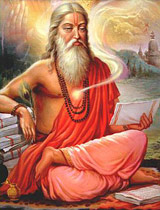Glossary
This small glossary shall help you to find your way around possibly new terms and expressions used throughout this website.
If you feel we missed a certain term or explanation, or something needs further clarification, you can let us know here.
Vedas
Vedas are considered as ancient Hindu Scripts. Though some people claim that they date back approximately 5,000 years - the reality is that the time of their origin is actually unknown to mankind.
In general we assume that all vedic scripts are in Sanskrit. However they are in Deva Nagari. There are majorly four Vedas: Rig veda, Yajur veda, Sama veda and Adharvana Veda.
More about the Vedas in relation to Heart Soul Meditation...
Sanskrit
Deva Nagari is considered as the Divine language. It's vocabulary offers a wide range of possibilities to express feelings with great accuracy. Later a saint called „Panini“ simplified the Deva Nagari for the sake of our understanding. This simplified version of Deva Nagari is also called as Samskruti (Sanskrit).
Patanjali
Patanjali is the name of a saint from Ancient India. He is well known to the world through his Ashtanga Yoga Principles - the Eight limbs of Yoga. He compiled the Yoga Sutras and gave a complete and whole perception of Yoga. He explained how yoga works on different levels of the human being like body, mind and soul through the Ashtanga Yoga.
Asanas (Body Postures)
Asanas are one of the eight limbs of Yoga (Ashtanga Yoga). Asanas are the body postures which majorly deal with the body but effect body, energy and even mind through nadis (subtle energy meridians) and the principle of reflexology.
Reflexology
Reflexology deals with applying gentle pressure on different parts of the body to unblock meridians and to enhance the flow of Chi.
Pranayama
Pranayama means “controlling the vitality through breathing”. Pranayama is also one principle in the eightfold (Ashtanga) path of Yoga.
Pranayama helps the body to provide the proper amount of oxygen to the blood. Certain Pranayama methods are further helpful to purify the energy meridians and Pranayama is also used to control the state of the mind.
Pancha Bhootas (5 Elements)
Pancha Bhoota is a Sanskrit term, which means „Five Elements“ that contains five tatvas. The five elements are:
- Earth
- Water
- Fire
- Air
- Space
These five elements are considered as major elements responsible for the formation of physical matter.
Kundalini (Negative Charge)
Just like for instance a bar magnet, the human being also has dual charges, a positive charge and a negative charge.The negative charge of the human being is called as "Kundalini". Generally speaking, the location of Kundalini is at the base of the spine, but the exact location is at the perineum region.
In Yoga, a lot of importance is given to the Kundalini practice for the development of the consciousness. However it must strictly be accompanied with proper guidance.
Siva (Positive Charge)
This term is used in different contexts and with different meanings. But on this website the term „Siva“ is used simply to denote the Positive charge of the human being. In Hatha Yoga, the practitioner tries to unite Kundalini with Siva by practising certain Asanas, Bandhas and Pranayama techniques.
Chakras (Energy Centres)
Chakras are considered as Energy centres of Pranamaya Kosa (Energy body). Each Chakra is connected to different parts of the body and they pass certain types of energies to the physical body through nadis (meridians). In Yoga and holistic healing lots of importance is given to the Chakras and there are many practices to keep them in a balanced state.
Pancha Kosas (5 Bodies)
Pancha Kosa is a Sanskrit term which means “Five Bodies”. According to Yoga, the human being has different levels of existence. Along with the physical body he has some subtle bodies too:
- Annamaya Kosa = Physical Body
- Pranamaya Kosa = Energy Body
- Manomaya Kosa = Astral Body
- Vignanamaya Kosa = Mental Body
- Aanandamaya Kosa = Causal Body
All these bodies together are called as Pancha Kosas, the five bodies of the human being. You can find more information on “The complete Human Being”.
Cosmic Energy - Microcosmic Energy
Similar to the light spectrum, there also exist different levels within energy itself. After physical matter becomes energy, it is considered as “Cosmic” energy. Further in this evolution and next to the cosmic, there is a superior level of energy which is called as “Microcosmic” energy.
Along with the physical body, the human being also has some subtle bodies and souls which are related to such energy levels and described in the “Complete Human Being”.
Aatmika Kosa (Aatmic Body)
According to Yoga, the human being has different levels of existence. Further to the subtle fields mentioned in the “Complete Human Being”, he has some other bodies like Bramha Maya Kosa, Nirvana Maya Kosa, Maha Nirvanamaya Kosa and Aatmika Kosa.
This Aatmika Kosa or Aatmic body contains Micro cosmic energy sources such as Soul and its sub sources in the human being, e.g. Incarnated soul, Heart soul, Navel soul and six other energy centres in hip, knees and sole regions.
The practices related to this Micro Cosmic energy can only be found in some specific Yoga traditions such as the Mahasiddha tradition.
Deha Veda (Physical Alchemy)
Deha veda means “Physical Alchemy”. It includes manufacturing of gold and attaining immortality by using herbs, Rasa, Upa rasa, Pashana, Upa Pashana, Kara and Sara.
Mano Veda (Mental Alchemy)
Mano veda means “Mental Alchemy” and includes practises like controlling the mind and using its mental faculties for the spiritual development.
Brmhatva state, Oneness (Spiritual Alchemy)
Briefly it can be explained as perceiving one's self in each and every particle of the universe and perceiving the the whole universe in one's self.
Aatma Vicharana (Self Analysis)
This sanskrit word means Self (Atma) Vicharana (Analysis). It majorly deals with the discretion of positive and negative thoughts, emotions and feelings and which to consider and which one to ignore.
Aatma Sakshatkara (Soul Realisation)
Next to Aatma Vicharana, the Aatma Sakshatkara comes. This means self realization. After lots of practice of Self analysis, the practitoner feels the existence of higher states beyond the mind. He then realizes the existence of Soul, which is considered as one of the main aims of the Yoga practitioner.


